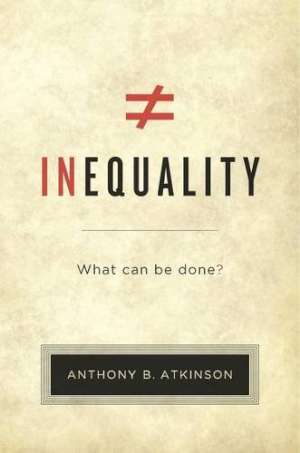24 June 2015
Inequality: What can be done?
Anthony B Atkinson
2015, Harvard University Press, 400 pages, £19.95
ISBN 9780674504769
Reviewer: Dame Kate Barker, Chairman, Society of Business Economists

In the wake of the considerable interest in Thomas Piketty’s work on wealth inequality, and just ahead of the 2015 general election, this book is very timely. Given Atkinson’s distinguished career as an economic thinker, it is no surprise that it begins with a careful discussion about just what forms of inequality are being discussed and an overview of different measures.
For the UK, the key observation is that inequality as measured by the Gini coefficient fell through the 20th century until an ‘inequality turn’ from around 1980. Since 1992, inequality overall has changed little. Atkinson points out that to get back to the more equal 1960s and 1970s just by changing tax rates would require the tax take to rise by 16% of income, and so pre-tax income inequality also has to be addressed. Data always contains surprises – on this measure the UK is now the most unequal of the major European economies, and quite a bit more unequal than France.
The UK also has a relatively high poverty rate (the proportion living on income below 60% of the median) and a high share of gross income going to the top 1% of earners. Atkinson points out the complications with these measures, but the general conclusion is that in the UK we are significantly more unequal than forty years ago (and from a global perspective there is also a need for redistribution between countries).
The most interesting part of the book discusses what, in previous periods, produced rising equality. In the UK post-war years, much was due to the operation of the welfare state, with both taxes and cash transfers playing a role. But incomes and capital also became distributed more equally. These trends then went into reverse partly for political reasons – and in an important section – due to changes in the relative costs of capital and labour with increasing automation. Additionally, owners of capital have been gaining more reward from it.
The remainder of the book works towards a set of proposals to return the UK in particular towards a more equal society – although these are intended to have broader application. There is also a discussion about how to improve global equality. Atkinson initially focuses on greater equality of incomes: among other changes via reforms to reinstate some trade union rights and the introduction of a multipartite Social and Economic Council.
He tackles the distribution of wealth, favouring a savings bond with a guaranteed real return and a capital endowment for all on reaching adulthood. These are supplemented by proposals intended to make taxation more progressive, to tax wealth more heavily, to restore a more generous role for social insurance and to offer a basic, conditional ‘participation’ income to all (where participation is not necessarily in the formal workforce).
Perhaps the least convincing part of the solutions concerns the role of innovation: it is not very clear to me how governments can ensure innovation works to improve employability.
Importantly, Atkinson also argues that there is no reason to presuppose measures to reduce inequality would also reduce growth – although that is a possibility. In that case there is an implication that slightly slower growth could be a price worth paying for a fairer society. In a UK context, the tax and spending changes are also modelled to assure the reader that they are fiscally affordable, if likely to be politically unpopular.
This is a highly coherent discussion of the issues around inequalities of income and wealth. However, the overall proposals in many ways would move the UK back towards the policy regime of the 1960s and 1970s, with potential loss of incentives for entrepreneurship. And while there is a strong focus is on equality of outcome as well as opportunity, it is to a large extent about financial equality. Issues around disability and health needs, which can also produce very unequal life experiences, are not really mentioned.
It is hard not to finish this book without reflecting that Atkinson must be depressed by present UK policy, which is by and large in the opposite direction to that which he suggests. Governments can indeed affect inequality – but that does not mean they always decrease it. If he is right to suggest that ‘extremes of inequality are incompatible with a functioning democracy’ perhaps we should all be more concerned.
